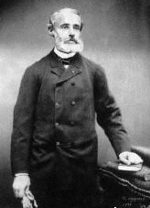Gaston Planté facts for kids
Quick facts for kids
Gaston Planté
|
|
|---|---|

Gaston Planté
|
|
| Born | 22 April 1834 |
| Died | 21 May 1889 (aged 55) |
| Nationality | French |
| Known for | lead–acid battery |
| Scientific career | |
| Fields | physics |
Gaston Planté (born April 22, 1834 – died May 21, 1889) was a French physicist. He is famous for inventing the lead–acid battery in 1859. This was the very first rechargeable electric battery sold for everyday use. Today, it is still widely used in cars.
Planté was born in Orthez, France. In 1854, he started working in Paris. He was an assistant teacher of physics at the Conservatory of Arts and Crafts. Later, in 1860, he became a Professor of Physics. An important lecture hall at that school is named after him.
In 1855, Planté made an exciting discovery. He found the first fossils of a huge prehistoric flightless bird. This bird was named Gastornis parisiensis after him. It was a giant bird, similar to the famous diatrymas found in North America.
The First Rechargeable Battery
In 1859, Gaston Planté created the lead-acid cell. This was a big step because it was the first battery that could be recharged after its power ran out.
His first battery was made from two sheets of pure lead. They were rolled up in a spiral shape. A linen cloth separated the lead sheets. This roll was placed in a glass jar filled with a sulfuric acid solution.
The next year, he showed off a battery with nine cells. This made it even more powerful. Later, in 1881, another inventor named Camille Alphonse Faure improved Planté's design. Faure's version was more efficient. It became very popular in early electric cars.
How Planté Explored Electricity
Planté also studied how different types of electricity worked. He looked at static electricity (like when you rub a balloon on your hair) and dynamic electricity (like from batteries).
To do this, he invented a special machine. He called it the Rheostatic Machine. This machine could create very high voltages. It used a series of capacitors and a clever spinning part. This allowed him to multiply the voltage from a battery.
With this machine, he could make long, bright sparks. He used it to study how electricity moves through air. He also looked at how high electric currents affected thin wires.
His Legacy
Gaston Planté passed away on May 21, 1889, near Paris. His work had a lasting impact.
In 1989, the Bulgarian Academy of Sciences created the Gaston Planté Medal. This award is given to scientists. It honors those who make important contributions to lead-acid battery technology.

